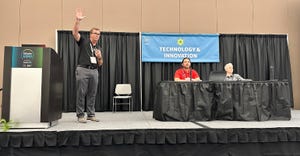Peel Residents Practice the Art of Separation
September 1, 1999
Melanie A. Lasoff
As part of a six-month pilot to test the feasibility of residential organics collection, about 1,900 households, including single family homes, rowhouses and apartments, are separating their waste for collection in the region of Peel, just northwest of Toronto, Ontario, Canada. The pilot began in April and ends in October.
The pilot also is designed to measure the effectiveness of using bags vs. 240-liter carts for collection and to determine the viability of bi-weekly garbage collection. At the beginning of the program, organics were picked up every week, while regular waste was picked up every other week.
To kick off the program in the 900,000-population region, several teams of Peel waste management office staff members went door to door in April delivering the bags, kitchen containers for food waste, and a calendar featuring collection days and other information, according to Melanie Kawalec, manager of waste program planning for Peel.
Public perception and program acceptance change is important to the pilot's success, Kawalec says. Consequently, a letter was sent to participants a month before the pilot, along with a customer survey about recycling and refuse disposal practices.
"We wanted to get the public's attitude [before the program] so we have something to compare it to after the six months," Kawalec says.
According to the first survey, many households participate in the region's blue box program, separating their recyclables - as well as leaf and yard waste - into special containers. The survey also indicated that residents were interested in recycling as much material as they could, Kawalec says.
For the pilot, organic waste includes all food scraps, soiled fibers such as pizza boxes and microwave popcorn bags, lint, feathers, and pet hair. Diapers, pet excrement and kitty litter are excluded. The collected material will be processed into compost and sold to end users. Some of the compost also will be distributed to residents.
The waste management staff randomly chose 400 single family homes and 400 medium-density homes - including townhomes, rowhouses and apartments. Eleven hundred households in a North Brampton ward of the chairman of the regional waste management subcommittee also participated. Half of the 1,900 participants received plastic bags for organics collection and half received carts.
So far, the only problem with the pilot has been the pick up change, Kawalec says. Picking up garbage every two weeks was supposed to be effective because most of the odorous material would be in the organic pick-up, which was once a week under the pilot program. However, that logic backfired, she says.
"It was too much all at once - everything was brand new for [participants]," she says. "Once we went back to garbage pick-up every week again, it's been quiet."
Now, three trucks in the region of Peel collect all waste on the same day: one for recycling, one for organic waste and one for municipal solid waste. In October, residents will go back to using the carts they used for garbage and separate containers for leaf and yard waste collection. Participants also will complete a survey about their attitudes toward the project, and whether they believe it is viable in the region. "Based on public attitude and issues, we'll consider region-wide organic pick-up," Kawalec says.
Collecting organic waste is beneficial to the community in the long-run, she continues. "When you can reduce your waste by up to 40 percent by [separating] organics [from the waste stream], it's a very good diversion initiative. [Organic waste] breaks down into a natural compost, so why bother filling your landfill site with it?"
You May Also Like


